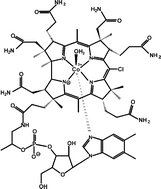Probing the nature of the Co(iii) ion in cobalamins: a comparison of the reaction of aquacobalamin (vitamin B12a) and aqua-10-chlorocobalamin with some anionic and N-donor ligands†
Abstract
To probe the cis effect of the

* Corresponding authors
a
Molecular Sciences Institute, School of Chemistry, University of the Witwatersrand, PO Wits, Johannesburg, South Africa
E-mail:
hmarques@aurum.chem.wits.ac.za
To probe the cis effect of the

 Please wait while we load your content...
Something went wrong. Try again?
Please wait while we load your content...
Something went wrong. Try again?
L. Knapton and H. M. Marques, Dalton Trans., 2005, 889 DOI: 10.1039/B416083E
To request permission to reproduce material from this article, please go to the Copyright Clearance Center request page.
If you are an author contributing to an RSC publication, you do not need to request permission provided correct acknowledgement is given.
If you are the author of this article, you do not need to request permission to reproduce figures and diagrams provided correct acknowledgement is given. If you want to reproduce the whole article in a third-party publication (excluding your thesis/dissertation for which permission is not required) please go to the Copyright Clearance Center request page.
Read more about how to correctly acknowledge RSC content.
 Fetching data from CrossRef.
Fetching data from CrossRef.
This may take some time to load.
Loading related content
